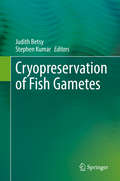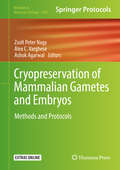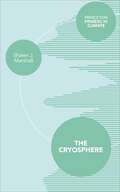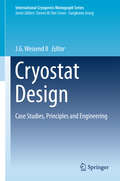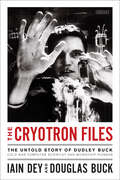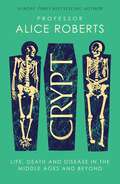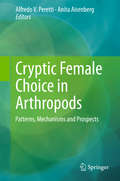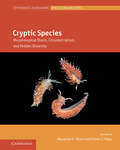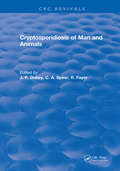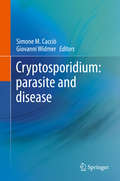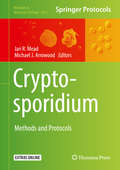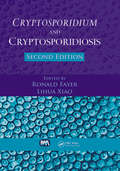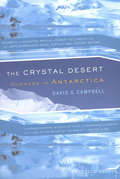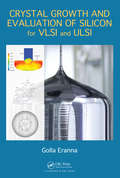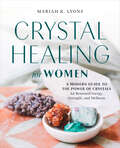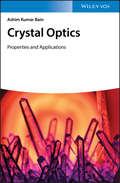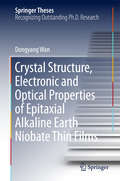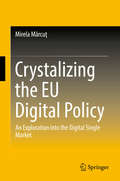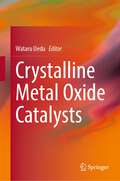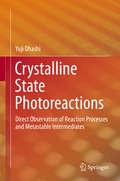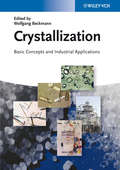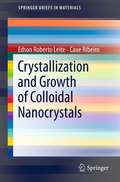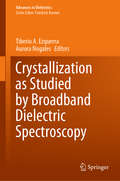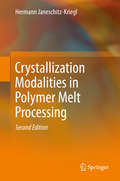- Table View
- List View
Cryopreservation of Fish Gametes
by Judith Betsy Stephen KumarUnderstanding the reproductive physiology and endocrinology of fishes is essential for captive maturation and seed production in the field of aquaculture. Studying the spermatology of fishes is a comparatively new focus in aquaculture, which has emerged as an important area of fish research over the past two decades. In this regard, the cryopreservation of fish gametes is a crucial aspect. Moreover, energetics studies of gametes have become essential, considering the loss of vigour in the spermatozoa after cryopreservation.The latest development in this context is the cryopreservation of spermatogonial stem cell, which is also covered in the book, along with detailed information on embryo cryopreservation in fishes and crustaceans. The role of cryopreservation in conservation programmes is another important aspect, one that will especially interest biologists.This book addresses central issues in fish gamete cryopreservation and breeding, while also reviewing the history of cryopreservation. Its most unique feature is the breadth of its coverage, from basic information on reproduction in fishes, to such advanced topics as embryo cryopreservation. Chiefly intended as a handy troubleshooting guide, the book represents a valuable resource for research students in related fields.
Cryopreservation of Mammalian Gametes and Embryos: Methods and Protocols (Methods in Molecular Biology #1568)
by Ashok Agarwal Alex C. Varghese Zsolt Peter NagyThis volume provides a comprehensive and technical presentation of numerous aspects of reproductive cell tissue cryopreservation, and presents readers with current procedures and detailed discussions of novel techniques and the latest innovations. The chapters in this book are divided into five parts and cover subjects such as: immature oocyte cryopreservation, human sperm vitrification and slow-freezing, directional freezing of ovarian tissue, automated vitrification systems, and detailed protocols on popular and commercially available cryopreservation/vitrification systems. Written in the highly successful Methods in Molecular Biology series format, chapters include introductions to their respective topics, lists of the necessary materials and reagents, step-by-step, readily reproducible laboratory protocols, and tips on troubleshooting and avoiding known pitfalls. Cutting-edge and practical, Cryopreservation of Mammalian Gametes and Embryos: Methods and Protocols includes chapters written by leading experts in the field and is a valuable resource for anyone interested in the field of cryopreservation.
The Cryosphere (Princeton Primers in Climate #4)
by Shawn J. MarshallThe cryosphere encompasses the Earth's snow and ice masses. It is a critical part of our planet's climate system, one that is especially at risk from climate change and global warming. The Cryosphere provides an essential introduction to the subject, written by one of the world's leading experts in Earth-system science. In this primer, glaciologist Shawn Marshall introduces readers to the cryosphere and the broader role it plays in our global climate system. After giving a concise overview, he fully explains each component of the cryosphere and how it works--seasonal snow, permafrost, river and lake ice, sea ice, glaciers, ice sheets, and ice shelves. Marshall describes how snow and ice interact with our atmosphere and oceans and how they influence climate, sea level, and ocean circulation. He looks at the cryosphere's role in past ice ages and considers the changing cryosphere's future impact on our landscape, oceans, and climate. Accessible and authoritative, this primer also features a glossary of key terms, suggestions for further reading, explanations of equations, and a discussion of open research questions in the field.
Cryostat Design: Case Studies, Principles and Engineering (International Cryogenics Monograph Series)
by J. G. Weisend IIThis book enables the reader to learn the fundamental and applied aspects of practical cryostat design by examining previous design choices and resulting cryostat performance. Through a series of extended case studies the book presents an overview of existing cryostat design covering a wide range of cryostat types and applications, including the magnet cryostats that comprise the majority of the Large Hadron Collider at CERN, space-borne cryostats containing sensors operating below 1 K, and large cryogenic liquid storage vessels. It starts with an introductory section on the principles of cryostat design including practical data and equations. This section is followed by a series of case studies on existing cryostats, describing the specific requirements of the cryostat, the challenges involved and the design choices made along with the resulting performance of the cryostat. The cryostat examples used in the studies are chosen to cover a broad range of cryostat applications and the authors of each case are leading experts in the field, most of whom participated in the design of the cryostats being described. The concluding chapter offers an overview of lessons learned and summarises some key hints and tips for practical cryostat design. The book will help the reader to expand their knowledge of many disciplines required for good cryostat design, including the cryogenic properties of materials, heat transfer and thermal insulation, instrumentation, safety, structures and seals.
The Cryotron Files: The Untold Story Of Dudley Buck, Pioneer Computer Scientist And Cold War Government Agent
by Iain Dey Douglas BuckThe riveting true story of Dudley Buck, the American computer scientist whose pioneering work with microchips placed him firmly in the sights of the KGB Dr. Dudley Allen Buck was a brilliant young scientist on the cusp of fame and fortune when he died suddenly on May 21, 1959, at the age of 32. He was the star professor at MIT and had done stints with the NSA and Lockheed. His latest invention, the Cryotron—an early form of the microchip—was attracting attention all over the globe. It was thought that the Cryotron could guide a new generation of intercontinental ballistic missiles to their targets. Four weeks before Dudley Buck’s death, he was visited by a group of the Soviet Union’s top computer experts. On the same day that he died from a mysterious sudden bout of pneumonia, his close colleague, Dr. Louis Ridenour, was also found dead from similar causes. Two top American computer scientists had unexpectedly died young on the same day. Were their deaths linked? Two years old when his father died, Douglas Buck was never satisfied with the explanation of his father’s death and has spent more than 20 years investigating it, acquiring his father’s lab books, diaries, correspondence, research papers and patent filings. Armed with this research, award-winning journalist Iain Dey tells, with compelling immediacy, the story of Dudley Buck’s life and groundbreaking work, starting from his unconventional beginnings in California through to his untimely death and beyond. The Cryotron Files is at once the gripping narrative history of America and its computer scientists during the Cold War and the dramatic personal story of rising MIT star Dudley Buck in the high-stakes days of spies, supercomputers, and the space and nuclear race.
Crypt: Life, Death and Disease in the Middle Ages and Beyond
by Alice RobertsThe new book by Sunday Times bestselling author of Ancestors and Buried - the final instalment in Professor Alice Roberts' acclaimed trilogy.We can unlock secrets from bones preserved for centuries in tombs, graves and crypts. The history of the Middle Ages is typically the story of the rich and powerful, there&’s barely a written note for most people&’s lives. Archaeology represents another way of interrogating our history. By using cutting-edge science to examine human remains and burials, it is possible to unearth details about how individuals lived and died that give us a new understanding of the past – one that is more intimate and inclusive than ever before. The seven stories in Crypt are not comforting tales. We meet the patients at one of the earliest hospitals in England and the victims of the St Brice&’s Day Massacre. We see a society struggling to make sense of disease, disability and death, as incurable epidemics sweep through medieval Europe. We learn of a protracted battle between Church and State that led to the murder of Thomas Becket and the destruction of the most famous tomb in England. And we come face to face with the archers who went down with Henry VIII&’s favourite ship, the Mary Rose. Beautifully written and expertly researched by Professor Alice Roberts, Crypt is packed with thrilling discoveries that will make you see the history of Britain afresh.
Cryptic Female Choice in Arthropods: Patterns, Mechanisms and Prospects
by Alfredo V. Peretti Anita AisenbergThis timely book revisits cryptic female choice in arthropods, gathering detailed contributions from around the world to address key behavioral, ecological and evolutionary questions. The reader will find a critical summary of major breakthroughs in taxon-oriented chapters that offer many new perspectives and cases to explore and in many cases unpublished data. Many groups of arthropods such as spiders, harvestmen, flies, moths, crickets, earwigs, beetles, eusocial insects, shrimp and crabs are discussed. Sexual selection is currently the focus of numerous and controversial theoretical and experimental studies. Selection in mating and post-mating patterns can be shaped by several different mechanisms, including sperm competition, extreme sexual conflict and cryptic female choice. Discrimination among males during or after copulation is called cryptic female choice because it occurs after intromission, the event that was formerly used as the definitive criterion of male reproductive success and is therefore usually difficult to detect and confirm. Because it sequentially follows intra- and intersexual interactions that occur before copulation, cryptic female choice has the power to alter or negate precopulatory sexual selection. However, though female roles in biasing male paternity after copulation have been proposed for a number of species distributed in many animal groups, cryptic female choice continues to be often underestimated. Furthermore, in recent years the concept of sexual conflict has been frequently misused, linking sexual selection by female choice irrevocably and exclusively with sexually antagonistic co-evolution, without exploring other alternatives. The book offers an essential source of information on how two fields, selective cooperation and individual sex interests, work together in the context of cryptic female choice in nature, using arthropods as model organisms. It is bound to spark valuable discussions among scientists working in evolutionary biology across the world, motivating new generations to unveil the astonishing secrets of sexual biology throughout the animal kingdom.
Cryptic Species: Morphological Stasis, Circumscription, and Hidden Diversity (Systematics Association Special Volume Series)
by Alexandre K. Monro Simon J. MayoCryptic species are organisms which look identical, but which represent distinct evolutionary lineages. They are an emerging trend in organismal biology across all groups, from flatworms, insects, amphibians, primates, to vascular plants. This book critically evaluates the phenomenon of cryptic species and demonstrates how they can play a valuable role in improving our understanding of evolution, in particular of morphological stasis. It also explores how the recognition of cryptic species is intrinsically linked to the so-called 'species problem', the lack of a unifying species concept in biology, and suggests alternative approaches. Bringing together a range of perspectives from practicing taxonomists, the book presents case studies of cryptic species across a range of animal and plant groups. It will be an invaluable text for all biologists interested in species and their delimitation, definition, and purpose, including undergraduate and graduate students and researchers.
Cryptosporidiosis of Man and Animals
by J. P. DubeyThis book attempts to provide a broad coverage of current information needed by public health workers, physicians, veterinarians, parasitologists, technicians, and various biologists who encounter or work with the parasitic disease Cryptosporidium.
Cryptosporidium: Parasite And Disease
by Simone M. Cacciò Giovanni WidmerThis new volume on Cryptosporidium and Cryptosporidiosis discusses all relevant aspects of the biology, molecular biology, host-parasite interaction, epidemiology as well as diagnosis and treatment of these widespread parasites. It represents a useful guide for physicians, microbiologists, veterinarians and water professionals seeking advanced knowledge and guidance about these important parasitic pathogens. A section on practical lab procedures discusses step-by-step guidelines for sample preparation and lab procedures. The new book may further serve as a reference work for graduate students in medical and veterinary microbiology.
Cryptosporidium: Methods and Protocols (Methods in Molecular Biology #2052)
by Jan R. Mead Michael J. ArrowoodThis book encompasses broad aspects of Cryptosporidium research with established methods that have been improved and expanded over the years as well as recent cutting-edge techniques. Within this collection are numerous molecular methods as well as protocols for genotyping and diagnostics, while also including room for in vitro cell culture techniques to address the issues with growing this difficult organism continuously. Written for the highly successful Methods in Molecular Biology series, chapters include introductions to their respective topics, lists of the necessary materials and reagents, step-by-step, readily reproducible laboratory protocols, and tips on troubleshooting and avoiding known pitfalls. Authoritative and practical, Cryptosporidium: Methods and Protocols serves as an idea guide to the inherent challenges of working with cryptosporidial parasites to provide a foundation for new investigators to build upon.
Cryptosporidium and Cryptosporidiosis
by Ronald Fayer Lihua XiaoFrom the microscopic observation of infection to the widespread application of molecular techniques in taxonomy and epidemiology, to the genome sequencing of two major species and advances in biochemistry, phylogeny, and water treatment, new information on this fascinating genus continues to mount as we discover and utilize the latest scientific te
The Crystal Desert: Summers in Antarctica
by David G. CampbellThe acclaimed author and biologist shares “a superb personal account [of Antarctica] . . . a remarkable evocation of a land at the bottom of the world” (Boston Globe).During the 1980s, biologist David Campbell spent three summers in Antarctica, researching its surprisingly plentiful wildlife. In The Crystal Desert, he combines travelogue, nature writing and science history to tell the story of life's tenacity on the coldest of Earth's continents. Between scuba expeditions in Admiralty Bay, Campbell remembers the explorers who discovered Antarctica, the whalers and sealers who despoiled it, and the scientists who laid the groundwork to decipher its mysteries. Chronicling the desperately short summers in beautiful, lucid prose, he presents a fascinating portrait of the evolution of life in Antarctica and of the continent itself.Winner of the John Burroughs Medal for Natural History Writing and a Houghton Mifflin Literary Fellowship
Crystal Fire: The Invention of the Transistor and the Birth of the Information Age (Sloan Technology Series)
by Michael Riordan Lillian Hoddeson"With impeccable scholarship and meticulous research, this book covers an impressive sweep of history from the discovery of the electron to the first integrated circuit. ... A definitive account of the birth of the semiconductor industry." -London Daily Telegraph "In rich detail, Riordan and Hoddeson unfurl the development of the transistor and the lives of its three principal discoverers- John Bardeen, Walter Brattain, and William Shockley. . . . Standing on the shoulders of giants while harvesting the fruits of their own astonishing research, the triumvirate of the transistor created the device that has revolutionized life today, making possible television, computers, and other electronic devices." -Library Journal
Crystal Growth and Evaluation of Silicon for VLSI and ULSI
by Golla ErannaSilicon, as a single-crystal semiconductor, has sparked a revolution in the field of electronics and touched nearly every field of science and technology. Though available abundantly as silica and in various other forms in nature, silicon is difficult to separate from its chemical compounds because of its reactivity. As a solid, silicon is chemical
Crystal Healing for Women: A Modern Guide to the Power of Crystals for Renewed Energy, Strength, and Wellness
by Mariah K. LyonsCrystal Healing for WomenA Modern Guide to the Power of Crystals for Renewed Energy, Strength, and WellnessDiscover the physical, mental, and spiritual healing power of crystals and awaken the healer within. Believed to hold restorative powers over our health, crystals have served humanity for millennia. With Crystal Healing for Women, you can unlock the ancient secrets of healing and wisdom held within these stones. Crystal healer and Reiki Master Mariah K. Lyons shares her knowledge in this beautifully-illustrated, practical guide that helps women awaken to their feminine divinity and healing powers, and rekindle their instinctual relationship with nature. She also shows you how to select and care for crystals and incorporate them in rituals. You'll learn to intentionally utilize crystals, helping you to find deeper levels of spiritual growth, integrated healing, and sustainable well-being. Crystal Healing for Women features: • Crystal healing fundamentals: How crystal vibrational energy works as well as how to activate, charge, and cleanse your crystals. • 40 energetic self-care rituals: Daily and seasonal wellness practices plus focused healing and manifestation for fertility, pregnancy, the feminine cycle, anxiety, creativity, and love. • 50 healing crystal profiles: Modern interpretations, individual features, and beautiful photographs of stones with energetic properties and healing compatibilities. • 10 key crystals for women: An in-depth look at select stones chosen for their potency, healing power, and connection to Divine Feminine energy. • Crystals in everyday life: Where to place them in your home and on your body and how to work with them and create crystal-healing grids.
Crystal Optics: Properties and Applications
by Ashim Kumar BainReviews the properties and applications of photo-elastic, acousto-optic, magneto-optic, electro-optic, and photorefractive materials This book deals with the basic physical properties and applications of photo-elastic, acousto-optic, magneto-optic, electro-optic, and photorefractive materials. It also provides up-to-date information on the design and applications of various optoelectronic devices based on these materials. The first chapter of Crystal Optics: Properties and Applications covers the basic concepts of crystal optics, such as index ellipsoid or optical indicatrix, crystal symmetry, wave surface, birefringence, and the polarization of light. Chapter 2 reviews the physical phenomena of crystal optics in isotropic and crystalline materials. It describes in detail research information on modern photoelastic materials and reviews the up-to-date photoelastic device applications. Chapter 3 develops the underlying theory of acousto-optics from first principles, formulating results suitable for subsequent calculations and design. The fourth chapter describes the basic principles of magneto-optic effects and mode of interaction with magnetic materials. The fifth chapter provides an understanding of the physical phenomenon of the linear and quadratic electro-optic effects in isotropic and crystalline materials. The last chapter collects many of the most important recent developments in photorefractive effects and materials, and pays special attention to recent scientific findings and advances on photorefractive materials and devices. -Features up to date information on the design and applications of various optoelectronic devices -Looks at the basic concepts of crystal optics, including the polarization of light, effects of reflection and transmission of polarization and light polarizing devices, and more -Pays special attention to design procedures for the entire range of acousto-optic devices and various applications of these devices -Provides research information on modern magneto-optic materials and reviews the up-to-date magneto-optic device applications?up to terahertz (THz) regime Crystal Optics: Properties and Applications is an excellent book for the scientific community working in the field, including researchers, lecturers, and advanced students.
Crystal Structure,Electronic and Optical Properties of Epitaxial Alkaline Earth Niobate Thin Films (Springer Theses)
by Dongyang WanThis impressive thesis offers a comprehensive scientific study of the alkaline earth niobates and describes their nonlinear optical properties for the first time. It explores the crystal structure, electrical properties, optical absorption properties, hot carrier dynamics, nonlinear optical property and strain-induced metal to insulator transition of alkaline earth niobates using advanced experimental techniques. These alkaline earth niobates can have a strong plasmon resonance in the visible range due to their large carrier density, and this unique property gives rise to the emergent phenomenon of photocatalysis and nonlinear optical properties. This series of intrinsic plasmonic materials based on niobates, can be used as a photocatalyst to split water under sunlight, a novel saturable absorber in the high-power ultrashort pulsed laser system, and as a sensor in microelectromechanical systems.
Crystalizing the EU Digital Policy: An Exploration into the Digital Single Market
by Mirela MărcuţThis book explores the intricate connection between the Single Market, characterized by the freedom of movement of goods, services, capital and labor within and across Europe, and the Digital Single Market, the virtual space that promotes freedom of movement of information and data. Both a result and catalyst of the Single Market, the Digital Single Market has become a different space from the Single Market, as the former is based on the application of information and communication technologies (ICTs), while the latter is the result of concerted actions and concessions by Member States in the European Union. The author argues that, similar to the Single Market, the Digital Single Market is an instrument, built by the influence of the Internet, which can provide a new means of socio-economic growth and development in Europe. While sharing many similar characteristics, the Single Market and the Digital Single Market diverge in important aspects, particularly with respect to policy. The research analyzes the interaction between policy actors, their influence in the European decision-making process, and their interests in order to establish a digital policy model, in comparison with market policy. Moreover, this volume considers the implementation process and the success of such initiatives under the current policy model, and puts forward policy recommendations. Ultimately, the author considers the utility of such research on digital policy, considering the current focus on migration, vulnerabilities to internal challenges (e. g. , Brexit) and security threats, maintaining that the discussion of digital policies relates to an innovative vision of the European integration process and prospects for its future.
Crystalline Metal Oxide Catalysts
by Wataru UedaThis book introduces the innovatively advanced crystalline metal oxide catalysts that have multi-catalytic functions on the basis of spatially placed elements in crystal structure. With authors who are experts in their fields, the chapters of the book are organized according to catalytic function, on the basis of crystal structure. The book also covers the structure determination of micro–nano-sized metal oxide crystals that are now standard in most catalytic materials and new trends in catalyst development using materials informatics and catalytic informatics. The information contained here will guide researchers who are eager to carry out sustainable catalytic processes and ultimately to achieve a sustainable society in their quest for catalyst development.
Crystalline State Photoreactions: Direct Observation of Reaction Processes and Metastable Intermediates
by Yuji OhashiThis book focuses on a variety of photochemical reaction processes in the crystalline state. The crystalline state reaction is a new category of solid state reaction, in which a reaction occurs with retention of the single crystal form. The whole reaction processes were observed directly by X-ray and neutron diffractions. In this book, not only the structures of metastable intermediates, such as radicals, carbenes, and nitrenes, but also the unstable species of photochromic compounds and photo-excited structures are shown with colored figures of the molecular structures, with more than 200 figures. The book is an indispensable resource not only for organic, inorganic and physical chemists but also for graduate students, as it furnishes more than 300 references.
Crystallization
by Wolfgang BeckmannCrystallization is a natural occurring process but also a process abundantly used in the industry. Crystallization can occur from a solution, from the melt or via deposition of material from the gas phase (desublimation). Crystals distinguish themself from liquids, gases and amorphous substances by the long-range order of its building blocks that entail the crystals to be formed of well-defined faces, and give rise to a large number of properties of the solid.Crystallization is used at some stage in nearly all process industries as a method of production, purification or recovery of solid materials. Crystallization is practiced on all scales: from the isolation of the first milligrams of a newly synthesized substance in the research laboratory to isolating products on the mulit-million tonne scale in industry. The book describes the breadth of crystallization operations, from isolation from a reaction broth to purification and finally to tailoring product properties.In the first section of the book, the basic mechanisms - nucleation, growth, attrition and agglomeration are introduced. It ensures an understanding of supersaturation, the driving force of crystallization. Furthermore, the solubility of the substance and its dependences on process conditions and the various techniques of crystallization and their possibilities and limitations are discussed. Last but not least, the first part includes an intensive treatment of polymorphism . The second part builds on the basics, exploring how crystallization processes can be developed, either batch-wise or continuous, from solution or from the melt. A discussion of the purification during crystallization serves as a link between the two sections, where practical aspects and an insight using theoretical concepts are combined. Mixing and its influence on thecrystallization as well as the mutual interference of down-stream processes with the crystallization are also treated. Finally, techniques to characterize the crop are discussed.The third part of the book is dedicated to accounts of actual developments and of carried-out crystallizations. Typical pitfalls and strategies to avoid these as well as the design of robust processes are presented.
Crystallization and Growth of Colloidal Nanocrystals (SpringerBriefs in Materials)
by Edson Roberto Leite Caue RibeiroSince the size, shape, and microstructure of nanocrystalline materials strongly impact physical and chemical properties, the development of new synthetic routes to nanocrystals with controlled composition and morphology is a key objective of the nanomaterials community. This objective is dependent on control of the nucleation and growth mechanisms that occur during the synthetic process, which in turn requires a fundamental understanding of both classical nucleation and growth and non-classical growth processes in nanostructured materials. Recently, a novel growth process called Oriented Attachment (OA) was identified which appears to be a fundamental mechanism during the development of nanoscale materials. OA is a special case of aggregation that provides an important route by which nanocrystals grow, defects are formed, and unique--often symmetry-defying--crystal morphologies can be produced. This growth mechanism involves reversible self-assembly of primary nanocrystals followed by reorientation of the assembled nanoparticles to achieve structural accord at the particle-particle interface, the removal of adsorbates and solvent molecules, and, finally, the irreversible formation of chemical bonds to produce new single crystals, twins, and intergrowths. Crystallization and Growth of Colloidal Nanocrystals provides a current understanding of the mechanisms related to nucleation and growth for use in controlling nanocrystal morphology and physical-chemical properties, and is essential reading for any chemist or materials scientist with an interest in using nanocrystals as building blocks for larger structures. This book provides a compendium for the expert reader as well as an excellent introduction for advanced undergraduate and graduate students seeking a gateway into this dynamic area of research.
Crystallization as Studied by Broadband Dielectric Spectroscopy (Advances in Dielectrics)
by Tiberio A. Ezquerra Aurora NogalesThis book presents new approaches that offer a better characterization of the interrelationship between crystalline and amorphous phases. In recent years, the use of dielectric spectroscopy has significantly improved our understanding of crystallization. The combination of modern scattering methods, using either synchrotron light or neutrons and infrared spectroscopy with dielectrics, is now helping to reveal modifications of both crystalline and amorphous phases. In turn, this yields insights into the underlying physics of the crystallization process in various materials, e.g. polymers, liquid crystals and diverse liquids. The book offers an excellent introduction to a valuable application of dielectric spectroscopy, and a helpful guide for every scientist who wants to study crystallization processes by means of dielectric spectroscopy.
Crystallization Modalities in Polymer Melt Processing: Fundamental Aspects Of Structure Formation
by Hermann Janeschitz-KrieglIn addition to structure formation in crystallizing polymers and semicrystalline polymers, this second edition completes the topic of transport phenomena. It also reviews solidification by crystallization during cooling and under flow or pressure, which all play an enormous role in polymer melt processing.Generally, there is an intensive interaction between three transport phenomena: heat transfer, momentum transfer (flow, rheology) and (flow induced) crystallization. The strong interaction between the three transport phenomena is a major challenge when it comes to experimentation, and advances in this area are detailed in the book, guiding further development of sound modeling. This book enables readers to follow an advanced course in polymer processing. It is a valuable resource for polymer chemists, applied physicists, rheologists, plastics engineers, mold makers and material scientists.
